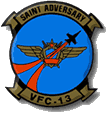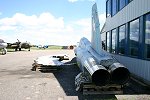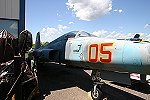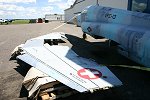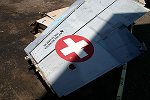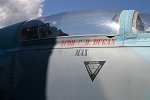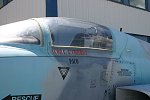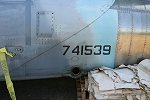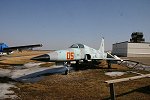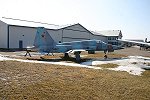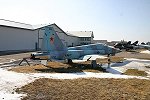|
|
AMERICAN WINGS AIR MUSEUM 74-1539 (USAF Number) |
VFC-13 Saints |
|||||
|
The Fighting Saints of VFC-13 can trace their origins back to 1946, when VF-753 was commissioned flying F6F-5 Hellcats. Today's squadron was formed on 1 September 1973 as VC-13, at NAS New Orleans during the reorganization of the U.S. Naval Reserve. Initially, the squadron operated the Chance Vought F-8H Crusader. In April 1974, the Saints made the transition to the single-seat A-4L Skyhawk. As the demand for west coast adversary services and other fleet support missions increased, the squadron was permanently transferred to NAS Miramar, arriving there in February 1976. That summer, a transition was made from the A-4L to the more reliable two-seat TA-4J. The year 1983 marked the return of the single seat aircraft to VC-13 and the arrival of the A-4E. The Fighting Saints provide a formidable dissimilar adversary threat. In recognition of that primary mission assignment, VC-13 was proudly redesignated as Fighter Squadron Composite 13 (VFC-13) April 22, 1988. October 1993 marked the end of an era when VFC-13 made the transition to the single-seat, two engine F/A-18 Hornet. This change further enhanced the squadron's ability to perform its adversary mission by providing an even more capable and realistic threat aircraft. However in April 1996, the command relocated to NAS Fallon and made the transition to the F-5E/F Tiger II, supported by McDonnell Douglas contract maintenance. |
|||||||
|
T he F-5E "Tiger II" was a greatly improved version of the earlier F-5A "Freedon Fighter". Redesigned as a highly maneuverable, lightweight and inexpensive air superiority fighter, the -E featured an air-to-air fire control radar system and a lead computing gunsight. More powerful J85 engines required the fuselage to be both widened and lengthened. The forward wing root was redesigned to give the "Tiger II" wing its characteristic triple delta shape.The first flight of the F-5E was on 11 August 1972. The first USAF unit to receive the aircraft was the 425th TFS at Williams AFB, Arizona responsible for training foreign pilots in the F-5 aircraft. The most well known use of the "Tiger II" was as an aggressor aircraft at the USAF Fighter Weapons School, Nellis AFB Nevada. The aggressor pilots of the 64th Fighter Weapons Squadron were trained in Soviet tactics and used the -Es to similate MiG-21s for training USAF and US Navy pilots in aerial combat skills. Eventually, aggressor squadrons were formed at RAF Alconbury, U.K. and Clark AB, PI for training USAF pilots stationed overseas along with pilots of friendly foreign nations. SPECIFICATIONS (F-5E) PERFORMANCE |
|||||||
|
|
|
|
|
||||
|
|
|
||||||
|
|
|
|
|||||
|
|
|
|
|||||
|
|
|
|
|
||||
